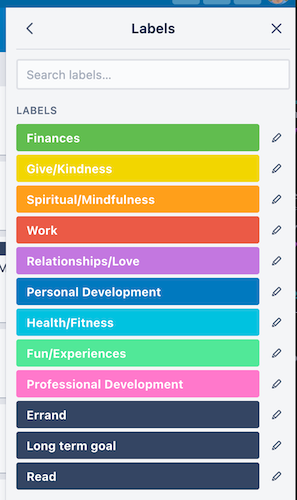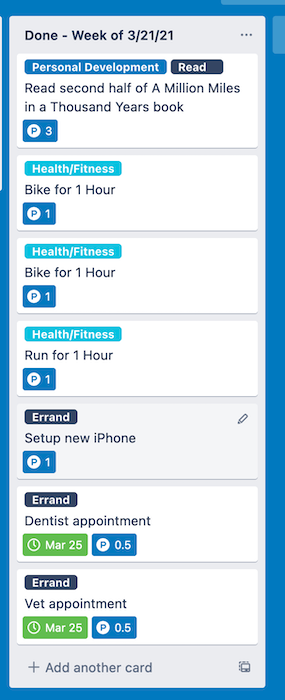Personal Agile
I tried just about every productivity system under the sun from Getting Things Done to simple to-do lists. For one reason or another, none of the systems stuck.
A few years back, my team at work started using Agile (more specifically Scrum). After spending a bit of time with Agile at work, I realized that it could be applied in my personal life as well. My Personal Agile framework was born, which I will share in this post. But first let’s do a quick overview of Agile…
Note: I’ll be using Agile and Scrum interchangeably here, even though Agile has a more generic definition than Scrum.
Brief Primer of Agile/Scrum
In Agile, work gets organized into units called user stories. The set of user stories live in a backlog. The backlog can be ordered by story priority. A story might be something like I want to read the book, The Personal MBA, so I can learn more about business. The story usually includes the who, what, and why.
After some stories are created, the next step in the agile process is refinement. In refinement, details are added that define what needs to be done in order for the story to be complete; these details are known as acceptance criteria. Some examples of the acceptance criteria that may get added to the read book story above are: 1) Finish readying The Personal MBA, 2) Take notes on topics of interest, 3) Review the notes at least three times.
Another part of the refinement process is pointing the story. A common practice is using a fibonacci pointing scale– 0.5, 1, 2, 3, 8, 13, 21. The number of points should indicate effort, which includes amount of time it will take to complete, complexity, and uncertainty.
Once there are a few refined stories, they can be ordered in terms of importance. Stories that are no longer relevant can be removed from the backlog. This process is referred to as backlog grooming.
A sprint is a focus period of work (usually 2-4 weeks in team scrum), where you plan to pull in enough story points off of the top of the backlog to fill the work time available in the sprint. After a sprint is complete, you do a retrospective of the sprint, reviewing what work was completed and how the process can be improved in the future.
That’s the basics of scrum in a nutshell.
Applying Agile to Personal Life
The first step to applying agile in your personal life is to find a tool or app to manage stories, sprints, backlogs, pointing, etc– anything from pen and paper to fancy apps work. A simple setup, which I use, is a Trello board with the Agile Tools Power Up. A simple spreadsheet can then be used to track sprints and point velocity over time.
Let’s walk through what this might look like in practice…
1. Create Labels for Each Area of Personal Life
The first step is to create a label for each area of life– things like personal finance, professional development, etc:

Stories can then be labeled with one or more these life labels.
2. Setup Backlog, Sprint, Doing Today, and Done Lists
We’ll also create Trello lists for the backlog, sprint, doing today, and done:

3. Review Previous Week
Before planning the next week’s sprint, do a quick review of what was accomplished last week:

In this example, I only finished 8 points ![]() , which is below my usual of around 12. Part of the reason for the shortfall this week is because I had a 5-point story to finish this blog post, which I will carry over to next week. Once the sprint is reviewed, it can be archived and a new Trello list for the next sprint’s Done stories can be created.
, which is below my usual of around 12. Part of the reason for the shortfall this week is because I had a 5-point story to finish this blog post, which I will carry over to next week. Once the sprint is reviewed, it can be archived and a new Trello list for the next sprint’s Done stories can be created.
3. Plan for the Next Weekly Sprint
It’s Sunday and that means it’s time to sprint plan for next week. As mentioned before, my current velocity is at 12-points-ish so I will pull in around that amount off of the top of my backlog. Pulling in stories with different labels ensure my week has a good life balance. Here is what I decided to plan for the week of 2021-03-28:

I am feeling ambitious this week so I am pulling in 16.5 points. I have a good mix of professional/personal development, health and fitness, and relationships stories.
4. At the Start Of Each Day Pull Items Into Today
At the start of each day, you can pull items off of the Sprint list into the Today list. Once items are completed throughout the day, they can be moved to Done. I also started putting long term goals like Save for an Emergency Fund into the Today list and leaving them sit until complete.
Where to Go From Here
I am currently on my 60th sprint, which means I have been doing personal agile for over a year. It’s definitely something that I will continue doing. The tools may change though. Another story on my backlog is to create an iOS app. Maybe creating a Personal Agile app is in my future ![]() ?
?
See a typo? Submit a Pull Request.